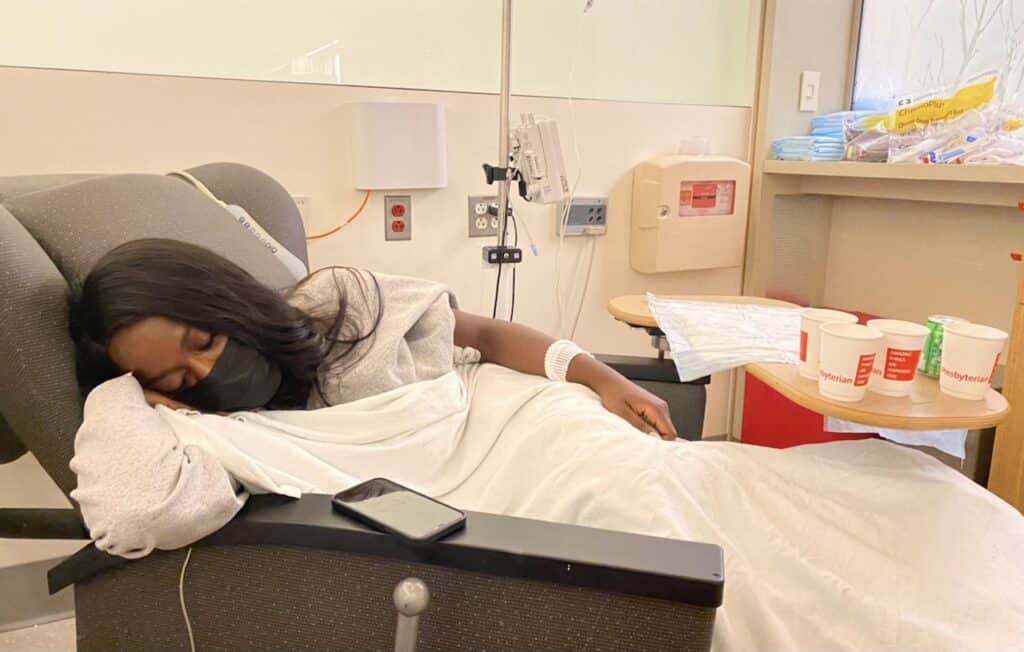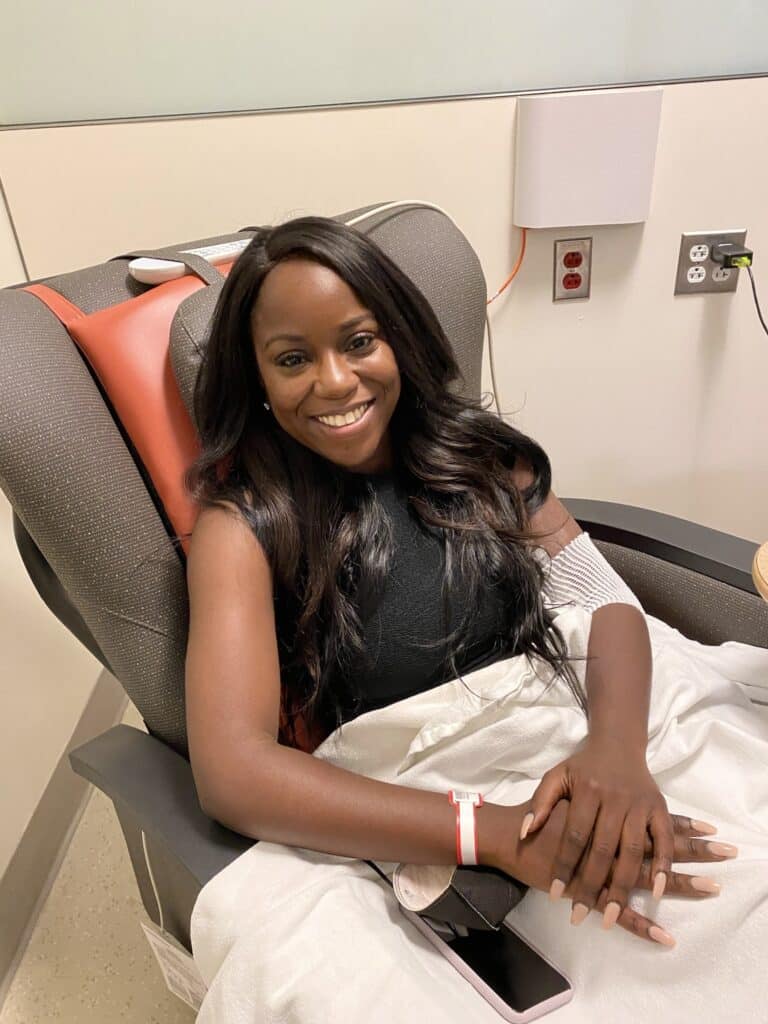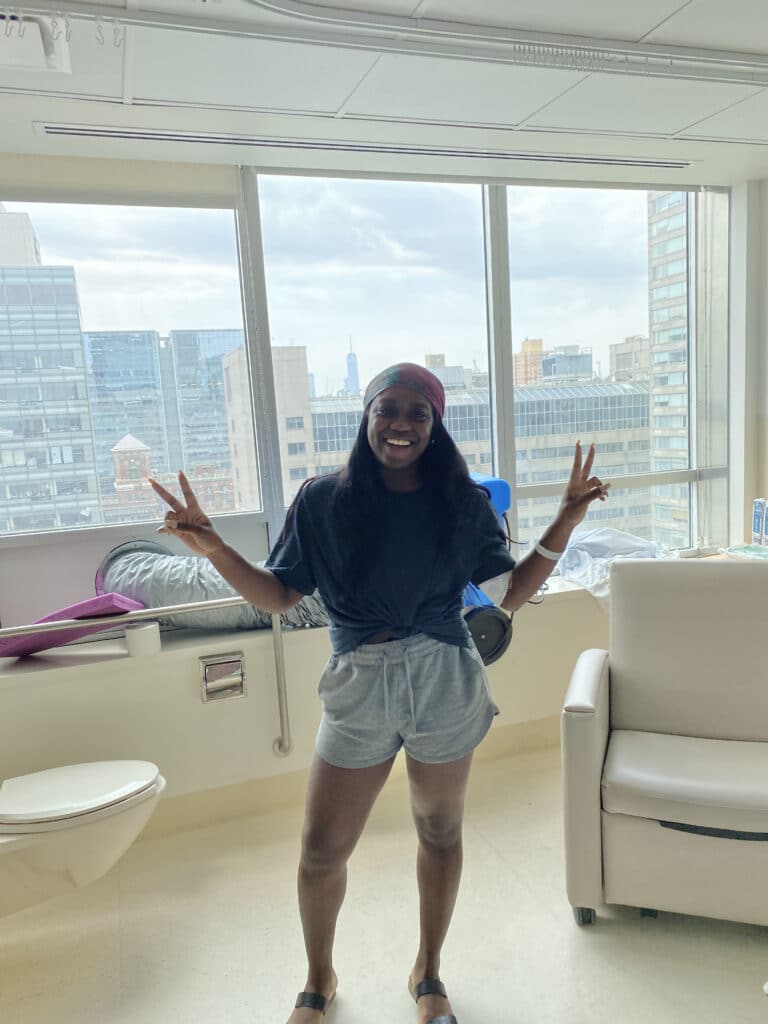The Importance of Being Seen and Heard

In April 2021, Paula Ngon was an active, young public relations professional living in New York City, navigating life amid a global pandemic. One day, not feeling well and concerned about swollen lymph nodes, she went to the emergency room but was sent home and told that nothing was wrong with her. With pressure on her neck increasing from her now golf ball–sized nodes, Ngon decided to trust her gut and booked an appointment with a doctor immediately. Thankfully, the physician she found listened to Ngon’s concerns and led her to an important diagnosis.
“The doctor instantly validated me, reassuring me that we would get to the bottom of whatever was going on with me,” says Ngon. After an X-ray and ultrasound, the physician shared with Ngon that she saw a shadow in her chest and immediately connected her with another doctor to get a biopsy. By the end of the following week, Ngon was diagnosed with Hodgkin lymphoma (HL).
FACING SETBACKS
After the initial shock waned and the reality of her diagnosis set in, Ngon’s lymphoma journey continued to throw challenges her way. As an otherwise healthy 26-year-old, Ngon elected to freeze her eggs before undergoing treatment, in case she wanted to start a family in the future. She experienced complications following the egg retrieval, and again, Ngon knew that something wasn’t right. Frustratingly, her concerns fell on deaf ears, and she took matters into her own hands and went to the emergency room. They discovered blood was filling up one of her lung cavities, and they had to perform a procedure to drain the blood so her lungs could expand again.

Chemotherapy brought its own complications. When Ngon’s port was put in for chemotherapy, her right arm felt numb, and when dropped by her side, it began to turn blue. She showed her oncologist and was told the tumor on that side could be causing her pain, and the anesthesia from the port procedure could be affecting the feeling in her arm. When Ngon had her port removed, she was hopeful these issues would subside. When it didn’t, she called her oncologist and was told to give it time and not to worry. As the days passed, the numbness and discoloration continued, and Ngon refused to accept that there wasn’t something bigger going on.
“I felt in that moment I had to challenge my doctor – challenge his authority and make him understand my issues were urgent,” recalls Ngon.
Ngon’s oncologist finally sent her to radiology, who immediately spotted that something was wrong and sent her to the emergency room, where they identified several blood clots up and down her arm. Due to the seriousness of blood clots, she spent over a week in the ICU for treatment. During the next few weeks, Ngon was overwhelmed with decisions she needed to make, and her oncologist was nowhere to be found. She made the important decision to look for a new doctor, someone she felt would listen to her needs and prioritize her health.
“As a Black woman having to go through that experience, I just felt like I wanted someone Black – or at least someone who knows someone – so that there’s accountability,” says Ngon.

Fortunately for Ngon, the president of the company she works for is also her executive sponsor for the Black employee resource group that Ngon leads in her workplace. This close relationship led Ngon to her new doctor, a connection of her company’s president. She had finally found the accountability and trust that she was seeking. Her new physician also happened to be a nationally recognized oncologist and member of the Lymphoma Research Foundation’s (LRF) Scientific Advisory Board.
“My experience with my new doctor was completely different – everyone took such great care of me,” says Ngon. “By the time I switched doctors I had already started chemo and understood my treatment plan, but I just felt like if I needed him, he was there. I felt like the compassion was there.”
ADVOCATING FOR HEALTH EQUITY

Ngon’s experience made her passionate about advocating for others who may not have the resources to advocate for themselves. She is quick to point out that her education, personal network, and understanding and salaried job all worked in her favor, but not every young Black woman being diagnosed with lymphoma is
as fortunate.
“Most people who look like me don’t have those advantages. It’s great that I was able to find a new doctor and everything worked out, but not everyone has that,” says Ngon. “I think that’s where my voice is most needed in this space.”
Throughout Ngon’s treatment, she faced a myriad of challenges, ranging from confusing billing practices to finding an in-network wig shop that understood the unique needs of Black women. Juggling recovery, being her own advocate, and maintaining the will to keep going, Ngon at one point wondered if she would survive. She recalls calling her dad and saying maybe she didn’t want to fight anymore, overwhelmed from fighting insurance companies, the stress, and the mountain of bills.

It was her doctor who helped Paula through – providing resources and care that
helped her see a path forward. Doing her own research, Ngon learned that lymphoma is a treatable disease, and survivors were living for 20 years and more. Over time, and as she made steady progress, her despair turned into optimism, and she made a goal to go to Italy when she was done with treatment to celebrate persevering.
On Dec. 1, 2021, Ngon’s doctor informed her she was in remission. Ringing in the new year on Jan. 1, 2022, she finally felt hopeful for the first time in a long while – and eventually took her trip to Italy to mark this momentous occasion.
Read More Articles from Pulse
Pulse is a publication of the Lymphoma Research Foundation, providing the latest updates on the Foundation and its focus on lymphoma and chronic lymphocytic leukemia (CLL) research, awareness, and education

